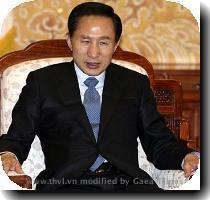South Korean investigator cites ‘high possibility’ external explosion sank naval ship
By APThursday, April 15, 2010
SKorea says external explosion likely sank ship
SEOUL, South Korea — An external explosion most likely sank a South Korean navy ship that split apart three weeks ago, an investigator said Friday, leaving open the possibility that a North Korean torpedo or mine may have caused the disaster.
The 1,200-ton Cheonan split into two pieces after exploding March 26 during a routine patrol near the tense maritime border with North Korea. Fifty-eight crew members were rescued and 38 bodies have been found, most of then Thursday when the stern was raised from the water.
There has been some suspicion, but no confirmation, of North Korean involvement in the sinking. The disputed western sea border has been the scene of three past inter-Korean naval battles.
South Korean officials have said they will look into all possibilities, including that the ship might have been struck by a North Korean torpedo or a mine left over from the 1950-53 Korean War. The conflict ended with an armistice, not a peace treaty, leaving the Koreas still technically at war.
North Korean officials have reportedly denied their country was involved in the blast.
“There is a high possibility of an external explosion rather than an internal explosion,” chief South Korean investigator Yoon Duk-yong told reporters Friday. He said further analysis and time are needed to determine the exact cause, after salvaging the ship’s other wreckage and collecting debris.
Yoon also said the explosion may have occurred near the ship or that something may have hit the ship.
Lee Hyun-yup, a marine engineering expert at Chungnam National University in South Korea, also said the ship was broken by an underwater explosion, which could be caused by either a torpedo or a floating mine.
To ascertain whether North Korea was involved, authorities would have to look at the shape of broken ship parts and recover splinters of a torpedo or a sea mine and determine whether the North had such weapons, Lee said, adding that it could take years to find the exact cause.
Meanwhile, Yang Moo-jin, a professor at Seoul’s University of North Korean Studies, doubted the North’s possible involvement, noting that Pyongyang was seeking cooperation with China while asking for direct talks with the U.S. for eventual resumption of stalled disarmament talks.
North Korea has told its officials that South Korea itself fabricated the sinking to justify its anti-Pyongyang policy, according to a report by Open Radio for North Korea, a Seoul-based radio station, citing an unidentified North Korean source.
The salvage of the ship began Thursday, with 36 bodies recovered. Two had been recovered earlier, and eight crew members still are unaccounted for, according to the Joint Chiefs of Staff.
A team of 38 investigators, including U.S. navy officials, conducted a preliminary investigation of the ship’s stern after lifting it out of the water. The stern was to be moved to a naval base to investigate the cause of the explosion while the remaining two-thirds of the ship is to be salvaged next week, military officials said.
The military is searching for debris within a 0.31-mile (500 meter) radius of the explosion site by using an unmanned underwater equipment, according to the Joint Chiefs of Staff.
South Korea’s Defense Minister Kim Tae-young said Seoul will follow up after the outcome of the investigation is available. He did not elaborate.
In March, North Korea’s main Rodong Sinmun newspaper warned in a commentary carried by the official Korean Central News Agency that the North would retaliate against the United States and South Korea if the two countries went ahead with their annual joint military drills in March. The North’s newspaper did not elaborate.
The North has long slammed military drills as a rehearsal for invasion. South Korea and the U.S. went ahead with the exercises, which they say are purely defensive.
The sinking was one of South Korea’s worst naval disasters. In 1974, a ship sank off the southeast coast in stormy weather, killing 159 sailors and coast guard personnel. In 1967, 39 sailors were killed by North Korean artillery.
Tags: Accidents, Artillery, Asia, East Asia, Explosions, Koreas, Lee Myung-bak, North America, North Korea, Search And Rescue Efforts, Seoul, South Korea, Territorial Disputes, Transportation, United States

